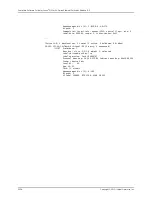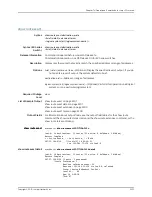
Table 285: show route detail Output Fields
(continued)
Field Description
Field Name
Route destination (for example:
10.0.0.1/24
). The
entry
value is the number of routes for this destination,
and the
announced
value is the number of routes being announced for this destination. Sometimes
the route destination is presented in another format, such as:
•
MPLS-label
(for example,
80001
).
•
interface-name
(for example,
ge-1/0/2
).
•
neighbor-address:control-word-status:encapsulation type:vc-id:source
(Layer 2 circuit only; for
example,
10.1.1.195:NoCtrlWord:1:1:Local/96
).
•
neighbor-address
—Address of the neighbor.
•
control-word-status
—Whether the use of the control word has been negotiated for this virtual
circuit:
NoCtrlWord
or
CtrlWord
.
•
encapsulation type
—Type of encapsulation, represented by a number: (1) Frame Relay DLCI, (2)
ATM AAL5 VCC transport, (3) ATM transparent cell transport, (4) Ethernet, (5) VLAN Ethernet,
(6) HDLC, (7) PPP, (8) ATM VCC cell transport, (10) ATM VPC cell transport
•
vc-id
—Virtual circuit identifier.
•
source
—Source of the advertisement:
Local
or
Remote
.
route-destination
(entry, announced)
(
Next-to-the-last-hop routing device for MPLS only) Depth of the Multiprotocol Label Switching
(MPLS) label stack, where the label-popping operation is needed to remove one or more labels from
the top of the stack. A pair of routes is displayed, because the pop operation is performed only when
the stack depth is two or more labels.
•
S=0 route
indicates that a packet with an incoming label stack depth of 2 or more exits this routing
device with one fewer label (the label-popping operation is performed).
•
If there is no
S=
information, the route is a normal MPLS route, which has a stack depth of 1 (the
label-popping operation is not performed).
label stacking
Protocol from which the route was learned and the preference value for the route.
•
+
—A plus sign indicates the active route, which is the route installed from the routing table into the
forwarding table.
•
-
—A hyphen indicates the last active route.
•
*
—An asterisk indicates that the route is both the active and the last active route. An asterisk before
a
to
line indicates the best subpath to the route.
In every routing metric except for the BGP
LocalPref
attribute, a lesser value is preferred. In order to
use common comparison routines, Junos OS stores the 1's complement of the
LocalPref
value in the
Preference2
field. For example, if the
LocalPref
value for Route 1 is 100, the
Preference2
value is -101.
If the
LocalPref
value for Route 2 is 155, the
Preference2
value is -156. Route 2 is preferred because it
has a higher
LocalPref
value and a lower
Preference2
value.
[protocol, preference]
(IS-IS only). In IS-IS, a single AS can be divided into smaller groups called areas. Routing between
areas is organized hierarchically, allowing a domain to be administratively divided into smaller areas.
This organization is accomplished by configuring Level 1 and Level 2 intermediate systems. Level 1
systems route within an area; when the destination is outside an area, they route toward a Level 2
system. Level 2 intermediate systems route between areas and toward other ASs.
Level
IP subnet augmented with a 64-bit prefix.
Route Distinguisher
Type of next hop. For a description of possible values for this field, see Table 286 on page 2196.
Next-hop type
2193
Copyright © 2010, Juniper Networks, Inc.
Chapter 74: Operational Commands for Layer 3 Protocols
Summary of Contents for JUNOS OS 10.3 - SOFTWARE
Page 325: ...CHAPTER 17 Operational Mode Commands for System Setup 229 Copyright 2010 Juniper Networks Inc ...
Page 1323: ...CHAPTER 56 Operational Mode Commands for Interfaces 1227 Copyright 2010 Juniper Networks Inc ...
Page 2841: ...CHAPTER 86 Operational Commands for 802 1X 2745 Copyright 2010 Juniper Networks Inc ...
Page 3367: ...CHAPTER 113 Operational Mode Commands for CoS 3271 Copyright 2010 Juniper Networks Inc ...
Page 3435: ...CHAPTER 120 Operational Mode Commands for PoE 3339 Copyright 2010 Juniper Networks Inc ...
Page 3529: ...CHAPTER 126 Operational Mode Commands for MPLS 3433 Copyright 2010 Juniper Networks Inc ...
















































